Intel Optane Memory has a mission: Make hard drives faster than SSDs

Intel’s Optane Memory could be the most revolutionary letdown in storage history. Announced Monday morning, these first consumer Optane-based devices will be available April 24 in two M.2 trims: A 16GB model for $44 and a 32GB Optane Memory device for $77. Both are rated for crazy-fast read speeds of 1.2GBps and writes of 280MBps.
If you’re wondering how you can install Windows 10 on one of these, you can’t. The first two Optane Memory devices instead are meant to be used primarily as cache drives for a traditional hard drive, using a technique similar to the Smart Response Technology Intel introduced in 2011.
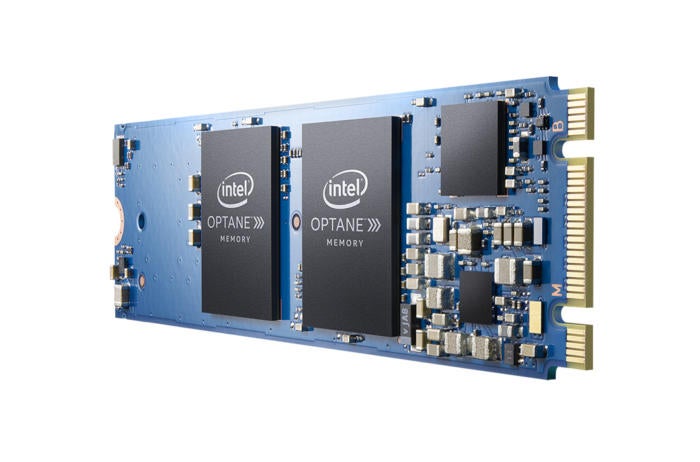 Intel
IntelThe first two consumer Optane devices will be used as cache drives to speed hard drives.
Why this matters: Optane Memory is a far cry from what we expected after Intel and Micron announced 3D XPoint in 2015. The non-volatile memory was hyped as the next fast thing, promising “1,000X” the performance of today’s NAND-based SSDs with far higher density and lower cost than DRAM. 3D XPoint had me wondering just how it would reshape the PC down the road, when a computer could potentially have a simple 4TB of 3D XPoint memory doing it all, rather than 16GB of RAM and a hard drive. Apparently we have to be patient.
Why you shouldn’t dismiss Optane
Anyone who expected the first Optane drives to re-balance the galaxy is likely to be very disappointed with Intel Optane Memory. These first two Optane drives aren’t intended for enthusiasts, nor anyone with a beefy computer. They’re aimed at the huddled masses who still use traditional, spinning-platter hard drives. There are a lot of them: IDC data cited by Intel shows roughly 80 percent of desktop PCs in the world still use hard drives. (Full disclosure: IDC and PCWorld are separate business units of International Data Group.) They’ll continue to do so, too, because the cost per megabyte is so affordable.
Add Optane Memory to a current PC, and drive performance will be exponentially better, Intel claims.
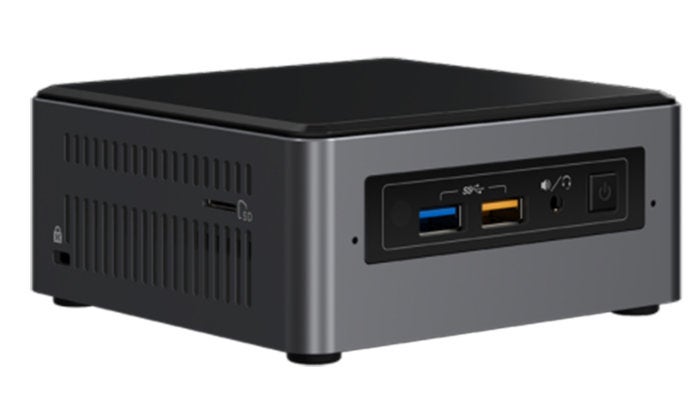 Intel
IntelWe previewed Optane Memory running in an Intel Kaby Lake NUC
Optane Memory hands-on
Intel let the media try Optane Memory during a recent briefing at the company’s Folsom, California campus. This was a controlled atmosphere: I was not allowed to take photographs or screenshots, and we were closely supervised by Intel staff. Take these observations with a grain of salt.
I booted a NUC PC with a 2.5-inch hard drive to Windows 10, launched the GIMP photo editor, and recorded how long it took to load. I then shut down the NUC and inserted a 32GB Intel Optane Memory drive into the NUC’s M.2 slot. I booted back into Windows and launched GIMP. Then I shut down the NUC and booted back into Windows.
Lather, rinse, repeat. With each duplicate task, the launching speed accelerated. The load time for Gimp, for example, dropped from about 14 seconds to 8 seconds, and then to 3 or 4 seconds as the Optane Memory cached the task.
While Optane Memory’s mission echoes that of Smart Response Technology, it’s a far better implementation. Pairing the drive, or setting it up to cache the hard drive, is truly a snap. You simply fire up the Optane Memory utility, tell it to pair, and you’re done.
 IDG
IDGIntel’s new Optane Memory borrows heavily from the 2011-era Smart Response Technology.
Anyone who remembers the original Smart Response Technology can tell you it wasn’t so easy to use and was prone to pairing problems. Like SRT, Intel Optane Memory keeps parts of the OS on the drive to speed up performance. This means if you want to pull the hard drive from the system, you’ll have to unpair it first so you don’t jeopardize your data.
The current Intel Optane Memory implementation is also limited to a single hard drive. If you run two hard drives, the second one will see no caching improvement. Very much like SRT, Intel Optane Memory increases responsiveness overall. Of course, anything is an improvement over a hard drive.
Competing with SSD
When the price of a 128GB SATA SSD is roughly $50 to $60 today, you may rightly wonder why Optane Memory would be worth the bother. Intel says most consumers just don’t want to give up the capacity for their photos and videos. PC configurations with a hard drive and an SSD, while standard for higher-end PC users, aren’t popular among newbies.
Think of the times you’ve had friends or family fill up the boot drive with cat pictures, but the secondary drive is nearly empty. Intel Optane Memory would give that mainstream user the same or better performance as an SSD, with the capacity advantage of the 1TB or 2TB drive they’re used to.
Intel claims Optane Memory performance is as good or better than an SSD’s, offering better latency by magnitudes and the ability to reach peak performance at much lower queue depths. (A queue depth is basically how long it takes the system to access data on the hard drive.) Here’s an Intel slide that shows the traces of several consumer applications in use. You can see all of the action is with a queue depth of one, two, or three at the most.
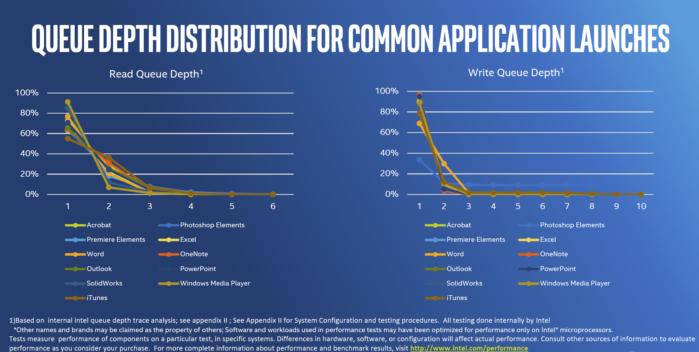 Intel
IntelIntel says the overwhelming amount of drive access consumers perform are done at very low queue depths.
Intel says the problem with NAND SSD is in its method of increasing performance: Increasing the number of channels nets performance only at very high queue depths that consumers don’t reach.
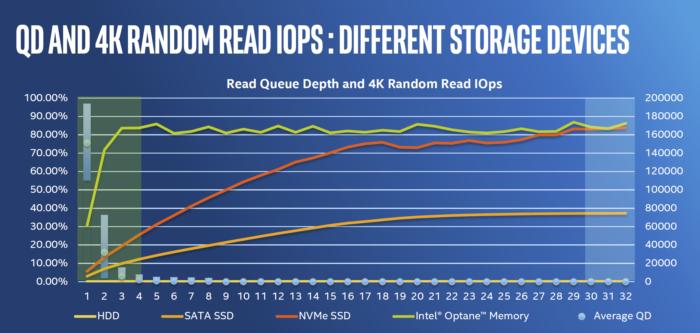 Intel
IntelUsing 3DX Point media, Intel’s Optane Memory can hit much higher performance than even SSDs at the low queue depths people actually use the computer at.
You probably want the next drive
What we all wanted to know, of course, is whether actual Optane SSDs aimed at consumers would come to market. Intel will only say that’s in the works.
If Intel repeats its previous pattern of offering consumer drives based on its server products, some hints may lie in the launch of the DC P4800X—see the roadmap for Optane SSDs in the lower right-hand corner.
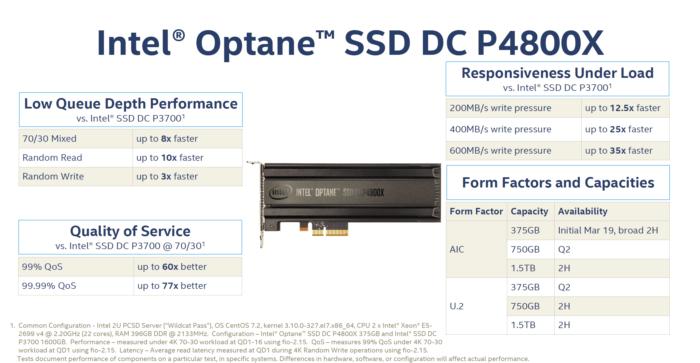 Intel
IntelIntel has announced a server Optane drive and plans for a consumer one. We’d guess this slide gives an indication of just what Intel’s plans are for consumers, too.
One limitation of Optane Memory could be a deal-breaker for many users: Intel says Optane Memory will be tied to Kaby Lake CPUs, and not just the associated 200-series chipsets. That means, for example, if you have a Z270 motherboard with a Skylake Core i7-6700K in it, it won’t work. Intel said it wanted to limit the validation work it had to do. We’d also guess that by limiting Optane to Kaby Lake, Intel gets to eliminate supporting Windows 7 and Windows 8.1.
Optane Memory’s first step
When something is hyped as “1,000X” of anything, people have expectations. The speed booster announced today falls short of the full-on SSD-killer performance enthusiasts were hoping for. All Intel says, though, is wait and see: Storage VP Rob Cooke described this first rollout of Optane as an “exciting moment in time” that would become the new normal.
Cooke actually compared Optane’s launch to the big changes brought about by the steam engine, electricity, space travel, the PC, and the interne. “I believe you will look back in time 10 years from now and say ‘I was there.’”
We’ll see.






